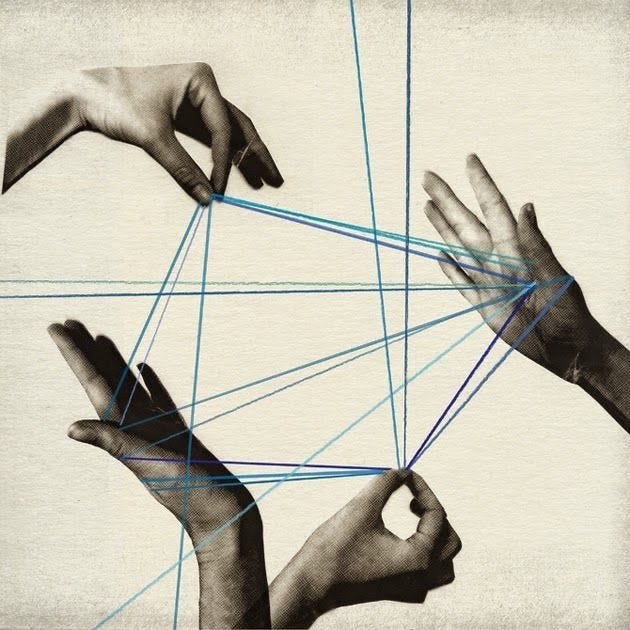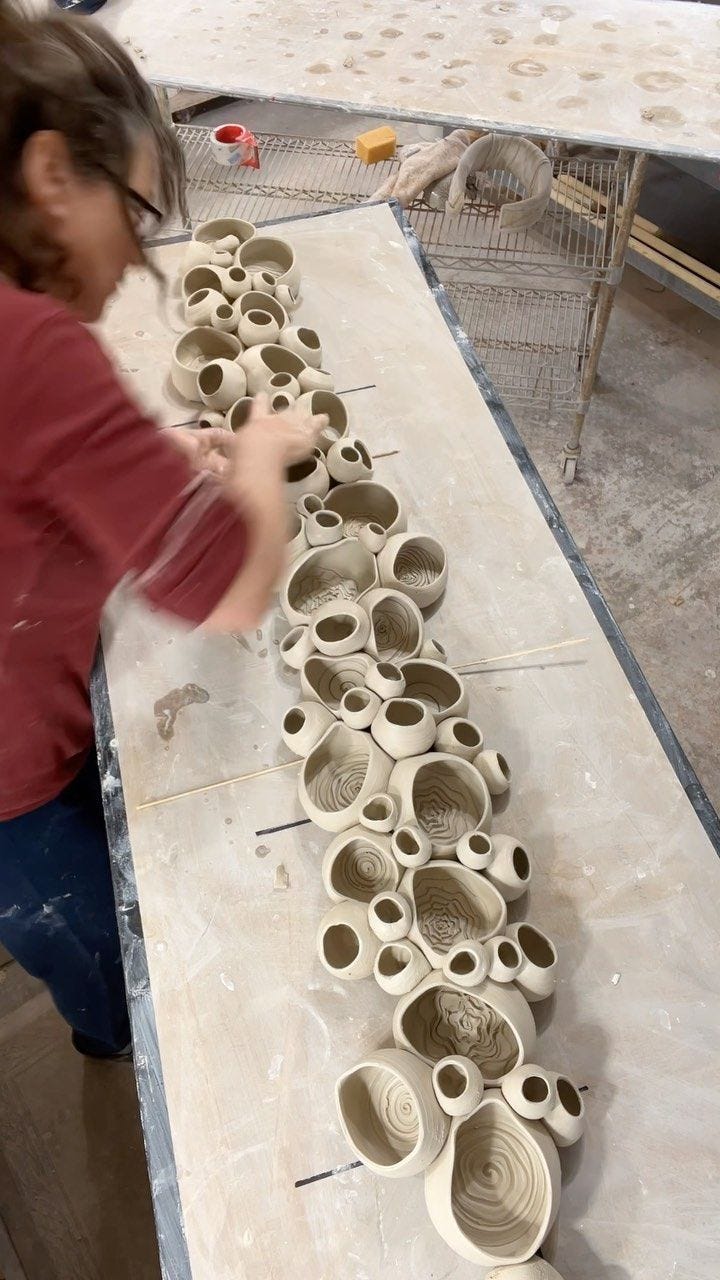The Axes of Resonance
Where Life Actually Happens
Last week, I explored how the relentless acceleration of modern life breeds alienation, a sense of drifting through routines without genuine connection. In contrast, Hartmut Rosa1 offers the idea of resonance: relationships marked by mutual transformation, authenticity, and a sense of emergence in how we engage with work and the world.
This week, I want to build on that foundation. I’ll explore Rosa’s distinct lines or dimensions along which individuals experience resonant relationships with the world. He talks about the horizontal, diagonal, and vertical axes of connection, and later added a fourth one, the axis of the self. Together they serve as a kind of compass that helps navigate life with greater presence and purpose.
During my transition from corporate leadership back to more creative work, I started paying attention to when I felt most alive. What I discovered surprised me.
It wasn't just the moments of personal breakthrough or artistic flow that energised me. It was also the inspiring conversations with colleagues where we challenged each other's thinking. The satisfaction of wrestling with a complex design challenge until the solution seemed to emerge from the materials themselves. The sense of connection to something larger when I stood in front of a piece of art that seemed to speak directly to my soul.
These weren't random experiences. They formed distinct patterns. And when I encountered Hartmut Rosa's framework for understanding resonance, everything clicked into place. Rosa identifies three fundamental axes along which humans experience resonant relationships: horizontal (with other people), diagonal (with the material world), and vertical (with life as a totality).
Understanding these three spheres has become a compass for navigating modern life, helping me recognise where I'm thriving, where I'm stuck, and where I need to invest more attention.
Horizontal Resonance: The Power of Human Connection
Horizontal resonance encompasses our relationships with other human beings, the fundamental social connections that make us who we are. This isn't just about having people in our lives. It's about relationships where we genuinely affect and are affected by each other.
My deepest understanding of horizontal resonance came through my work facilitating group learning experiences. There's something magical that happens when people feel safe enough to be vulnerable with each other. In my leadership trainings, I've watched senior executives become more human as they share their struggles. I've seen teams transform when they move beyond task-focused interactions to recognise each other's humanity genuinely.
This is what Rosa means by horizontal resonance: moments when the "resonant wire of sympathy and trust" connects us to others in ways that change everyone involved.
Family relationships often serve as our first horizontal axis – a potential "harbour of resonance" where we experience unconditional acceptance. Friendship represents this resonance at its most voluntary, where true friends offer what Rosa calls the "power to contradict," thriving on difference and disagreement within a trusted connection. Even politics, when functioning effectively, represents horizontal resonance on a large scale: the possibility that our individual voices can collectively influence decisions.
Diagonal Resonance: When the Material World Speaks
Diagonal resonance describes our responsive relationships with the material world: objects, tools, environments, and the physical challenges we engage with. This might seem counterintuitive at first. How can we have a "relationship" with things?
My background in art school gave me early access to diagonal resonance, though I didn't have words for it then. When I worked with clay, paint, or digital media, there were moments when the materials seemed to have their own voice – when the work began to guide its own creation.
This isn't mystical thinking; it's recognition that materials have their own properties, constraints, and possibilities. The clay pushes back, the paint bleeds in unexpected ways, the code produces surprising results. In these moments of resistance and response, something alive emerges between the creator and the created.
Rosa identifies work as a primary mode of diagonal resonance. When work functions well, we experience "self-efficacy" as the material begins to "respond" to our actions. The tragedy of much modern work is that it's been stripped of this resonant quality. When work becomes purely instrumental (just a means to a paycheck) we lose access to one of our most fundamental sources of meaning and energy.
True learning also happens through diagonal resonance, when "some specific segment of world" is made to "speak" to us. The best teachers create what Rosa calls a "triangle of resonance" between educator, students, and subject matter, where all sides begin to "vibrate" together.
Vertical Resonance: Connection to the Totality
Vertical resonance encompasses our relationships with existence itself, with life as a whole, with totalities that exceed our individual experience. These are moments when the world "obtains its own voice" and speaks to us about meaning, purpose, and our place in the larger scheme of things.
Vertical resonance often involves a sense of being connected to something larger than ourselves – whether that's nature, art, history, or the sacred. When we experience ourselves as part of natural systems rather than separate from them, we access what Rosa calls a "passive, pathic" mode of being affected by the world's rhythms and patterns.
In our secular age, art has largely taken the place of religion as a primary sphere of vertical resonance. Great art doesn't just entertain or decorate – it "demands" something from us. It can "touch and move" us in ways that require us to grow, to see differently, to become more than we were.
I remember standing in front of a Rothko painting during my foundational year at art school, and feeling like the colours were breathing, as if the canvas were somehow alive. The experience lasted maybe thirty seconds, but it shifted something fundamental in how I understood what art could do.
Axis of the Self (a later addition)
Hartmut Rosa’s resonance theory originally described three axes: with others, the material world, and with the transcendent. In 2021, he and Andreas Reckwitz2 introduced a fourth: resonance with the self.
This dimension explores the quality of our relationship with our own body, mind, and emotions. It emphasises a non-alienated, embodied connection to oneself (being fully present, emotionally authentic, and self-accepting).
Unlike mere self-reflection or introspection, resonance with the self is a lived, felt experience. It involves being in tune with one’s inner world in a way that is responsive, vibrant, and alive. This internal resonance does not replace the other axes but complements them, forming a more integrated experience of the world.
What Does Resonance with the Self Look Like?
Embodied Presence: Practices like yoga or mindful movement that foster awareness of bodily sensations and promote being fully present.
Emotional Authenticity: Allowing oneself to feel and express emotions genuinely, without suppression or distortion.
Self-Acceptance: Moments of inner peace, compassion toward oneself, or an uncritical acknowledgment of one’s own thoughts and feelings.
Resonance with the self serves as the foundation for engaging meaningfully with the world around us. When this axis is neglected, even strong social or spiritual connections can feel hollow. But when it is nurtured, it deepens and stabilises our ability to resonate across all dimensions of life.
How the Spheres Interconnect
While it's useful to understand these three axes separately, they're constantly interacting in real life. The most powerful experiences often involve multiple forms of resonance simultaneously: A meaningful conversation with a friend while walking in nature and perhaps working together on a creative project.
The key insight is that a flourishing life requires access to all three spheres. When one axis becomes dominant at the expense of others, we become unbalanced. When multiple axes are compromised, we risk the kind of alienation that characterises much of modern life.
Stay tuned. Next week, we'll explore how to recognise your own resonance patterns and create conditions for deeper connection across all three spheres.
Have a great week ahead!
Graziella
Rosa, H. (2019). Resonance: A Sociology of Our Relationship to the World. Polity Press.
Rosa, H., & Reckwitz, A. (2021). Spätmoderne in der Krise. Suhrkamp.






This post resonated with me a lot! It also reminded me of resonances in the axis described here. In the diagonal axis I notice it in my work, when writing software: At some point, the code stops fighting back and both coder and codee become one common understanding. Thank you for giving me vocabulary for this!
It's pretty much like the article https://paulgraham.com/makersschedule.html: I need to know I have at least half a day of uninterrupted time to just immerse myself into the problem. And it needs to be something I'm interested in / care about - busy work doesn't get me there.